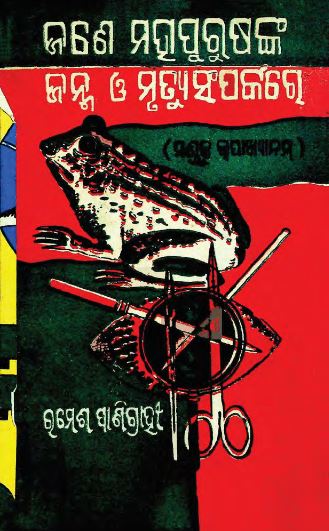Jane Mahapurusanka Janma O Mrutyu Samparkare, written by Rames Panigraphi and published originally in 1973 with a celebrated second edition in 1986, stands as a milestone in modern Odia drama. This innovative work, a sub-drama in the series Manduka Upakhyanam, explores the cyclic nature of existence through the dramatic interplay of life and death. In the complex tapestry of Panigraphi’s narrative, the themes of birth and death are investigated not merely as two distinct events but as essential, intertwined processes that define the human condition.
In this seminal drama, Panigraphi employs a unique blend of classical storytelling techniques fused with modern dramaturgical elements to challenge the audience’s perception of time, fate, and destiny. The play’s title itself hints at the duality present in every moment of human life, suggesting that every birth carries within it the seeds of an eventual demise. Through rich symbolism and layered dialogues, the drama probes the existential questions that have intrigued philosophers and poets over centuries. Panigraphi’s nuanced narrative is both reflective and critical, encouraging spectators to contemplate the inevitable cycles that govern nature and human society.
The sub-drama Manduka Upakhyanam, positioned within this larger framework, adds a distinctive flavor to the piece. Manduka Upakhyanam, derived from the traditional folklore of Odia literature, reimagines the ancient myth of transformation and renewal. The interplay between mythical allegory and contemporary existential dilemmas creates a dynamic stage where characters symbolize both mortal striving and the transcendental truths of existence. With every scene, Panigraphi artfully negotiates between the tangible realities of everyday life and the abstract, elusive nature of destiny. The characters are drawn in vivid detail, their lives symbolizing a microcosm of society’s broader journey from inception to cessation.
What sets this drama apart is its lyrical dialogue and compelling stage directions that evoke strong visual imagery. The narrative is interspersed with poetic monologues and pointed rhetorical exchanges that elucidate the interplay of opposites – the genesis of ideas and the inevitable decay that follows. Panigraphi’s depiction of the cosmic cycle is not just a dramatic assertion but also invokes a meditative reflection on the eternal dance of creation and destruction that underpins all existence.
In Jane Mahapurusanka Janma O Mrutyu Samparkare, the audience is invited to witness not only the unfolding drama on stage but also an introspective exploration of the self’s journey. This thought-provoking work continues to resonate with modern audiences for its profound insights, blending age-old wisdom with the immediacy of contemporary life. As a significant contribution to Odia literature, Panigraphi’s drama remains a touchstone for discussions on mortality, transformation, and the cyclical rhythm of life, making it a perennial source of inspiration and introspection.
This drama captures a unique synthesis of philosophical inquiry and artistic experimentation, representing a bold departure from conventional narratives in Odia theatre. The deliberate juxtaposition of mythic allegory and real-world reflection offers patrons of the stage a lens through which life’s ephemeral moments are celebrated and mourned with equal fervor and grace in this remarkable production. The work endures timelessly.
Books Info
| Books name | Jane Mahapurusanka Janma O Mrutyu Samparkare |
| Author | Rames Panigraphi |
| No Of pages | 118 |
| Publisher | Bijaya Book Store |
| Publication | 1973, 1986 2e. |
| Printed At | Santosh Printers |
| Distributor | NA |
Jane Mahapurusanka Janma O Mrutyu Samparkare Sample
Jane Mahapurusanka Janma O Mrutyu Samparkare Full Pdf Download

